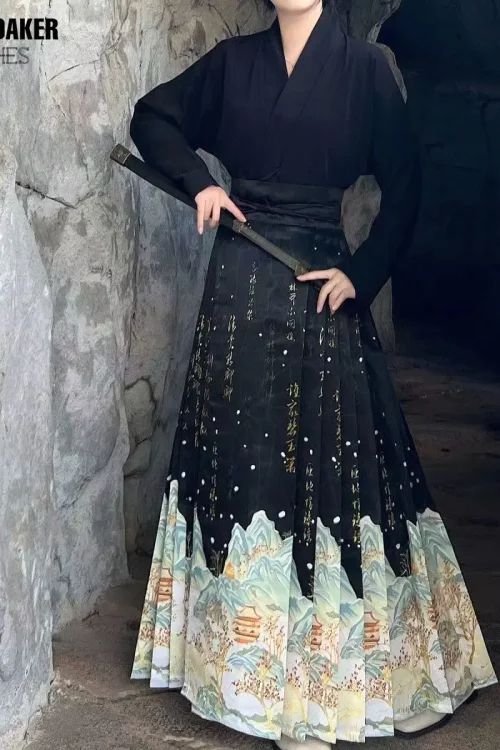Versace’s Moderno Twist on the Traditional Mamianqun Saia
Versace, the renowned Italian fashion house, has unveiled a captivating interpretation of the iconic mǎmiànqún skirt, a traditional Chinese garment steeped in cultural significance. This bold reimagining seamlessly blends the essence of the original with Versace’s signature aesthetic, resulting in a captivating fusion of heritage and modernity.

Characteristics of the Mǎmiànqún
The mǎmiànqún, meaning “saia com cara de cavalo,” has been a cherished part of Chinese culture for centuries, characterized by its distinctive pleated design and vibrant colors. Versace’s interpretation retains the skirt’s pleated silhouette but infuses it with a contemporary twist through the use of luxurious fabrics and intricate embellishments.
Luxurious Fabrics and Colors
The collection features skirts crafted from opulent silks and satins, adorned with intricate embroidery and beading. The vibrant hues of the original mǎmiànqún are reimagined in a sophisticated palette, ranging from deep reds and emerald greens to delicate pastels.
Empowerment and Movement
Versace’s modern take on the mǎmiànqún extends beyond its visual appeal. The skirts are designed to empower the wearer, embodying the strength and confidence associated with the traditional garment. The pleated design allows for fluid movement, while the luxurious fabrics exude a sense of opulence and femininity.
Signature Versace Elements
The collection also incorporates elements of Versace’s signature style, such as the iconic Medusa head motif and bold prints. These elements are subtly woven into the design, creating a harmonious blend of tradition and innovation.
Cultural Heritage and Fashion
Versace’s interpretation of the mǎmiànqún skirt is a testament to the enduring power of cultural heritage. By reinterpreting this iconic garment, Versace has not only created a stunning fashion statement but also paid homage to the rich traditions of Chinese culture. The collection is a testament to the transformative power of fashion, its ability to bridge cultures and inspire creativity.
The Evolution of the Mǎmiànqún Skirt: Versace’s Bold Interpretation
Versace’s recent collection has sparked a renewed interest in the iconic mǎmiànqún skirt, a traditional Chinese garment that has captivated fashion enthusiasts for centuries. This bold interpretation showcases the enduring allure of the mǎmiànqún while infusing it with a contemporary edge.

Historical Background
The mǎmiànqún, meaning “horse face skirt,” originated during the Qing dynasty and was worn by Manchu mulheres. Its distinctive features include a high waist, pleated front, and an A-line silhouette. Versace’s rendition retains these classic elements while introducing innovative details.
Vibrant Hues and Luxurious Fabrics
The collection features mǎmiànqún skirts in vibrant hues, such as emerald green and cobalt blue, that evoke the opulence of the Qing court. The fabrics, ranging from luxurious silks to shimmering brocades, add a touch of grandeur. However, Versace’s interpretation goes beyond mere imitation.
Intricate Embellishments
The skirts are adorned with intricate embroidery and embellishments, showcasing the brand’s signature maximalist aesthetic. Gold thread and crystal beads create eye-catching patterns that dance across the fabric, adding a touch of glamour to the traditional design.
Innovative Silhouettes
Furthermore, Versace has experimented with the skirt’s silhouette. Some pieces feature exaggerated pleats that create a voluminous effect, while others have a more streamlined shape. The collection also includes mǎmiànqún-inspired dresses, offering a modern take on the classic garment.
Conclusão
Versace’s bold interpretation of the mǎmiànqún skirt has not only revived interest in this historical piece but has also demonstrated the adaptability of traditional designs to contemporary fashion. By blending the essence of the past with the innovations of the present, Versace has created a collection that celebrates the enduring power of cultural heritage while pushing the boundaries of fashion.
